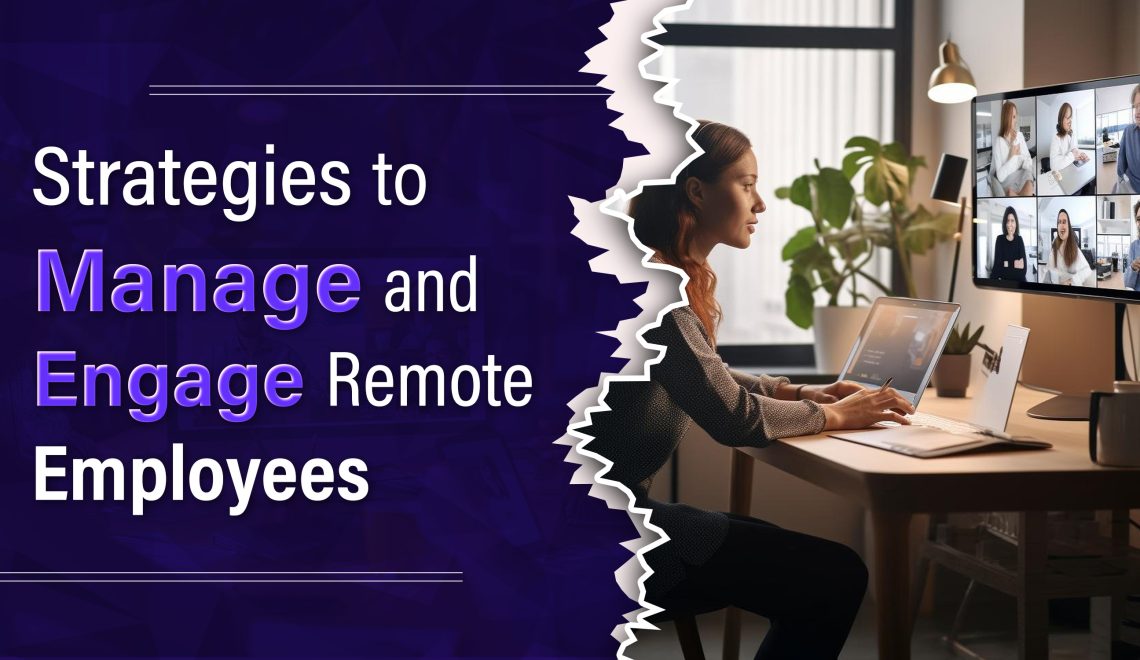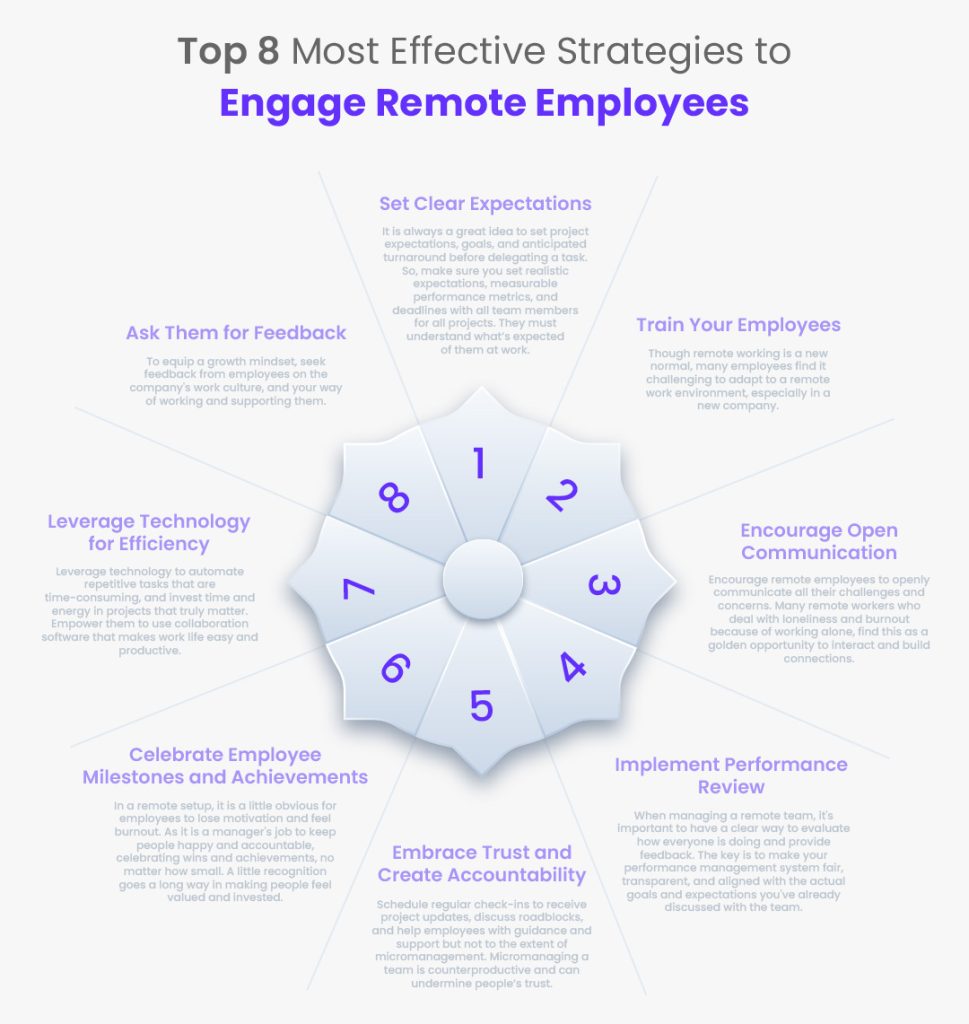
The growth of remote work is exponential!
Yet, we can’t ignore the fact that remote work is still a very new concept for a lot of people, and even for managers, this means they will almost certainly face challenges in having to manage, lead, and inspire a remote team.
So, in this blog post, we will find some of the common challenges remote team managers face and 8 powerful-proven strategies to effectively manage your remote team.
What Are the Common Challenges Managers Face While Managing Remote Employees?
The global pandemic when opened wide doors for hybrid work arrangements, 98% of employees expressed their desire to work remotely for the flexibility and work-life balance it offers.
To leverage talents where they are, 56% percent of companies begin accommodating remote employees. However, there are some challenges that all managers face while managing remote teams:
Lack of Effective Communication
While hybrid working styles offer freedom and flexibility, communication is a major challenge. Without proper processes in place, chances are employees will misinterpret the guidelines and confuse the tasks allocated to them. Misinformed employees are resentful and less productive.
To mitigate the risk of misinterpretations, encourage open communication at all levels. Achieving the right balance between keeping people informed and respecting their boundaries lays down the base for effective communication in a remote work environment.
Challenges of Tracking Progress
Team management is a task on its own. It may be easier to understand and keep track of employees’ progress in an offline setting than remote working.
A team of remote employees faces numerous hiccups that managers may be unaware of. Working beyond office walls also makes it difficult for managers to keep a track record of the remote team’s progress and accomplishments. Visibility is lost with people losing sight of organisational vision.
Overall, managers struggle as they cannot observe remote teams in person. To deal with this, focus on creating a progress tracker system with Asana, ClickUp, or Trello. With KPI metrics, expectations from employees are set, regardless of the region they are working from.
Difficulty in Collaboration
When working in person, connections are naturally built. While in a remote setting that transcends geographical boundaries, building trust is a task!
Remote employees are less likely to meet and cross paths with a co-worker living cities away. Thus, hindering proactive collaborations.
The limited face-to-face interactions make it equally challenging for managers to establish a sense of responsibility and accountability within the team.
How Do You Manage Remote Teams Effectively?
When employees don’t feel a connection with the people they’re working with, the stakes of the blame game in challenging times are high. As a manager, build a workplace culture where employees feel valued, supported, and appreciated.
Brainstorming sessions are a great way to unify remote teams where people will proactively communicate their ideas and come up with innovative solutions, lowering the risk of disengagement.
Top 8 Most Effective Strategies to Engage Remote Employees
At SBL, we bring together remote teams and engage them towards our business vision using the following strategies:
Set Clear Expectations
It is always a great idea to set project expectations, goals, and anticipated turnaround before delegating a task.
So, make sure you set realistic expectations, measurable performance metrics, and deadlines with all team members for all projects. They must understand what’s expected of them at work.
Fix a weekly meeting schedule that works for all employees working from different time zones. This ensures everyone is on the same page with the progress of all projects and tasks.

Train Your Employees
Though remote working is a new normal, many employees find it challenging to adapt to a remote work environment, especially in a new company. As a manager, you should focus on providing end-to-end training related to their job responsibilities and equip them with project management tools for better performance.
Encourage Open Communication
No remote task can make-do without effective communication.
Encourage remote employees to openly communicate all their challenges and concerns. Many remote workers who deal with loneliness and burnout because of working alone, find this as a golden opportunity to interact and build connections.
A manager must foster an environment of transparency where people voice their opinions, ask questions, and provide feedback without hesitation. Remember, encouraging open channels of communication is a crucial key to managing remote teams efficiently.
Implement Performance Review
When managing a remote team, it’s important to have a clear way to evaluate how everyone is doing and provide feedback. The key is to make your performance management system fair, transparent, and aligned with the actual goals and expectations you’ve already discussed with the team.
Have regular check-ins, maybe every two weeks or once a month. Use this time to review what milestones or projects each person is working on. Discuss how things are going, what’s going well, and what obstacles they may be facing. This gives insight into their performance in real time.
Be sure to provide constructive feedback during these check-ins. The goal is to help your team members grow with suggestions on how to improve.
Embrace Trust and Create Accountability
Schedule regular check-ins to receive project updates, discuss roadblocks, and help employees with guidance and support but not to the extent of micromanagement. Micromanaging a team is counterproductive and can undermine people’s trust.
Instead of constantly monitoring how and when team members are working, make people accountable for the tasks they’re handling. Empower them to take ownership of their tasks and make decisions within their scope of responsibility.
Celebrate Employee Milestones and Achievements
In a remote setup, it is a little obvious for employees to lose motivation and feel burnout. As it is a manager’s job to keep people happy and accountable, celebrating wins and achievements, no matter how small. A little recognition goes a long way in making people feel valued and invested.
Leverage Technology for Efficiency
Leverage technology to automate repetitive tasks that are time-consuming, and invest time and energy in projects that truly matter. Empower them to use collaboration software that makes work life easy and productive.
Not wasting cycles on repetitive tasks helps remote employees with effective time management.
Ask Feedback
The best managers know that the feedback loop has to go both ways.
To equip a growth mindset, seek feedback from employees on the company’s work culture, and your way of working and supporting them. Maybe do an anonymous survey every few months asking, “What could I do more of?” or “What could I do less of?” to improve as a manager. Or just open the door informally during your one-to-one to get their candid feedback.
Your commitment to continuous learning and improving the ways to lead a team uplevel the entire team’s performance.
Conclusion
From dealing with communication barriers to maintaining employee motivation and ensuring that they are doing work productively, the role of managers is challenging and demanding.
I hope these 8 strategies will pave the way for effective team management. Do let me know in the comments below which ones you will use to help your remote team thrive.
Follow me on LinkedIn
Frequently Asked Questions
1. What are some common challenges in managing remote teams?
Key challenges in managing remote teams include a lack of effective communication, difficulty tracking progress, and establishing trust and accountability among the distributed team members.
2. How to monitor and maintain the performance of remote teams?
To monitor and maintain the performance of remote teams, set clear expectations. Have realistic goals and performance metrics in place. Schedule weekly sync meetings for all projects to align on progress and to effectively utilise collaboration tools.
3. How to properly train remote employees?
Provide comprehensive training on job responsibilities, processes, and project management tools to equip remote staff with the knowledge and resources needed to perform effectively.
4. What is the best way to keep remote team members connected to the organisation?
Strategies to keep remote team members connected to the organisation include regular video meetings, team-building activities, clear and consistent communication, using collaboration tools effectively, and ensuring that employees have access to resources and support networks.
5. How to encourage open communication within my remote team?
Foster an environment of transparency where employees feel comfortable in openly communicating their challenges, concerns, ideas, and feedback.
6. How can you improve as a remote manager?
Actively seek feedback from employees through surveys or informal conversations on how you can better support them and areas for your improvement as a leader.



